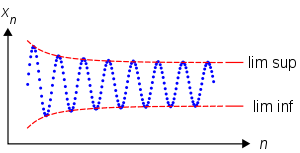Oscillation (mathematics)
In mathematics, the oscillation of a function or a sequence is a number that quantifies how much that sequence or function varies between its extreme values as it approaches infinity or a point. As is the case with limits, there are several definitions that put the intuitive concept into a form suitable for a mathematical treatment: oscillation of a sequence of real numbers, oscillation of a real-valued function at a point, and oscillation of a function on an interval (or open set).

Definitions
Oscillation of a sequence
Let be a sequence of real numbers. The oscillation of that sequence is defined as the difference (possibly infinite) between the limit superior and limit inferior of :
- .
The oscillation is zero if and only if the sequence converges. It is undefined if and are both equal to +∞ or both equal to −∞, that is, if the sequence tends to +∞ or −∞.
Oscillation of a function on an open set
Let be a real-valued function of a real variable. The oscillation of on an interval in its domain is the difference between the supremum and infimum of :
More generally, if is a function on a topological space (such as a metric space), then the oscillation of on an open set is
Oscillation of a function at a point
The oscillation of a function of a real variable at a point is defined as the limit as of the oscillation of on an -neighborhood of :
This is the same as the difference between the limit superior and limit inferior of the function at , provided the point is not excluded from the limits.
More generally, if is a real-valued function on a metric space, then the oscillation is
Examples
.svg.png)
- 1/x has oscillation ∞ at x = 0, and oscillation 0 at other finite x and at −∞ and +∞.
- sin (1/x) (the topologist's sine curve) has oscillation 2 at x = 0, and 0 elsewhere.
- sin x has oscillation 0 at every finite x, and 2 at −∞ and +∞.
- The sequence 1, −1, 1, −1, 1, −1, ... has oscillation 2.
In the last example the sequence is periodic, and any sequence that is periodic without being constant will have non-zero oscillation. However, non-zero oscillation does not usually indicate periodicity.
Geometrically, the graph of an oscillating function on the real numbers follows some path in the xy-plane, without settling into ever-smaller regions. In well-behaved cases the path might look like a loop coming back on itself, that is, periodic behaviour; in the worst cases quite irregular movement covering a whole region.
Continuity
Oscillation can be used to define continuity of a function, and is easily equivalent to the usual ε-δ definition (in the case of functions defined everywhere on the real line): a function ƒ is continuous at a point x0 if and only if the oscillation is zero;[1] in symbols, A benefit of this definition is that it quantifies discontinuity: the oscillation gives how much the function is discontinuous at a point.
For example, in the classification of discontinuities:
- in a removable discontinuity, the distance that the value of the function is off by is the oscillation;
- in a jump discontinuity, the size of the jump is the oscillation (assuming that the value at the point lies between these limits from the two sides);
- in an essential discontinuity, oscillation measures the failure of a limit to exist.
This definition is useful in descriptive set theory to study the set of discontinuities and continuous points – the continuous points are the intersection of the sets where the oscillation is less than ε (hence a Gδ set) – and gives a very quick proof of one direction of the Lebesgue integrability condition.[2]
The oscillation is equivalence to the ε-δ definition by a simple re-arrangement, and by using a limit (lim sup, lim inf) to define oscillation: if (at a given point) for a given ε0 there is no δ that satisfies the ε-δ definition, then the oscillation is at least ε0, and conversely if for every ε there is a desired δ, the oscillation is 0. The oscillation definition can be naturally generalized to maps from a topological space to a metric space.
Generalizations
More generally, if f : X → Y is a function from a topological space X into a metric space Y, then the oscillation of f is defined at each x ∈ X by
See also
- Wave equation
- Wave envelope
- Grandi's series
- Bounded mean oscillation
References
- Introduction to Real Analysis, updated April 2010, William F. Trench, Theorem 3.5.2, p. 172
- Introduction to Real Analysis, updated April 2010, William F. Trench, 3.5 "A More Advanced Look at the Existence of the Proper Riemann Integral", pp. 171–177
- Hewitt and Stromberg (1965). Real and abstract analysis. Springer-Verlag. p. 78.
- Oxtoby, J (1996). Measure and category (4th ed.). Springer-Verlag. pp. 31–35. ISBN 978-0-387-90508-2.
- Pugh, C. C. (2002). Real mathematical analysis. New York: Springer. pp. 164–165. ISBN 0-387-95297-7.